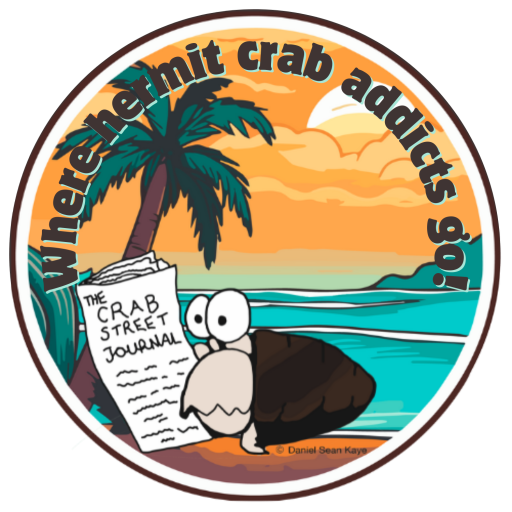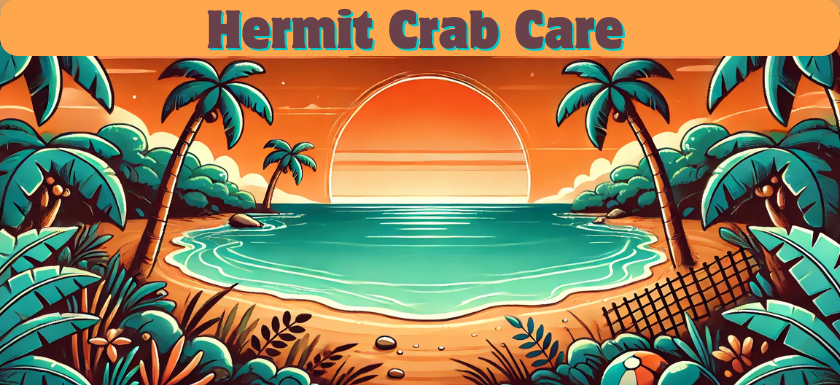
This guide will help you care for a hermit crab that has been attacked, lost several limbs or is suffering from molt complications. General care instructions will be outlined and special exceptions for molting crabs will be included at the end of the guide. If this a newly purchased hermit crab that is dropping limbs you should check out our information on Post Purchase Death Syndrome. PPDS is a common cause of dropped limbs. Dropping multiple limbs indicates extreme stress. Not all hermit crabs can recover from this type of limb loss.
Isolate
The victim hermit crab needs to be isolated. Use a secure container that other hermit crabs can not access. The victim will remain in isolation until healthy enough to return to the main group. The time in isolation depends on the severity of the attack. A badly injured crab may need to be isolated until the next molt.
The isolation unit should have the same humidity and temperature as the main tank. (Recommended: 80F/80%)
Include a hut or some other place to hide. Shallow substrate, spare shells, food and water are all needed. Each will be discussed below.
In some cases, a small kritter keeper can be turned into an isolation unit and placed in the main tank. With the screen lid secure the other crabs will not be able to harm the victim. This is less stressful as there is no environmental changes for the hermit crab to adapt too. This also allows him to be near his tank mates.
How do I set up a proper hermit crab habitat?
Shells
If your crab is also out of it’s shell that needs to be addressed first. Our cup method is tried and true and works in all but the worst cases. Provide 2 or 3 spare shells in the isolation unit once the crab is back in a shell.
How do I get my hermit crab back in it’s shell?
Food
Eating well is vital to the recovery process. Commercial hermit crabs foods are 99% unsafe. Most include chemicals that inhibit the molt process and/or are used as a pesticide. We strongly discourage ever feeding commercial foods but feeding them to an already sick crab will only worsen the situation. A natural diet of real food is best.
A hermit crab needs both claws to eat properly. One claw holds the food while the other tears or breaks off a small bit and then brings it up to the mouth. If your hermit crab is missing one claw they can still feed themselves but you will have to alter their diet. Soft foods that do not require tearing or breaking should be fed. Calcium rich foods can be ground into a powder and mixed with another food or fed dry.
If your hermit crab is missing both claws they will have to be hand fed. This means all foods will need to be ground into a powder and moistened slightly. You will dip a toothpick into the food and bring it up near the mouth. The mouth parts should reach down and take the food. If your hermit crab will not eat from you in this way, put a small amount of food in a bottle cap. Position the hermit crab over the cap so they can simply dip their mouth into it.
Change the food daily. Keep the food dish very close to where the hermit crab is resting. This will minimize the need to walk.
A diet consisting of all the key food groups is vital for recovery. Honey can be used to stimulate appetite or give a little boost but it does not have much nutritional value and should only be fed in a very tiny amounts due to the risk of it spreading to the body and gills. You could use honey as a base for other foods you have ground up but safe water or oil is a better option.
Water
Land hermit crabs can drink water without their claws if they are able to move themselves over the dish. Use small, shallow dishes such as a bottle cap. Keep both kinds of water very close to where the hermit crab is resting. If the hermit crab can walk a bit you can use a wide shallow dish. Change daily or when empty. Water must be treated with Prime or a similar water conditioner.
Substrate
Use shallow play sand for your substrate in isolation. While in normal conditions deep sand is needed that isn’t recommended in this scenario.
Why?
In this situation the crab most likely does not have the strength or ability to dig properly.
The injured hermit crab needs to remain above ground so you can ensure they are eating and drinking.
When the victim is ready to molt again he will be able to safely surface molt in the isolation unit. If he does not move into the hiding place you provided, carefully place it over him. It would not hurt to cover the isolation unit for a few days during the molting process to reduce stress. Shadows passing over the hermit crab signal predator danger, a cover will minimize that additional stress.
Light
Continue to maintain a normal cycle of 12 hours light and 12 hours dark. It is not critical to provide UVB in the isolation unit. If you already have a UVB light set up on the main tank and will be keeping the isolation unit inside the main tank that is fine.
Return to the colony
How will you know your hermit crab is ready to return to the colony?
Are all the limbs regenerated? At the very least your hermit crab needs both claws. This means they will be able to protect themselves inside their shell, as well as feed themselves and climb to escape other crabs if needed.
Is the hermit crab active and eating and drinking normally again?
Able to climb in and out of your water pools unassisted?
If yes to all of the above it is time to return to the main tank. When you do return the hermit crab to the colony do it when you can be around to monitor the tank for a few hours.
Molting crabs
It is rare that a molter will be attacked by tank mates. When this does occur it is a result of incorrect substrate (eco earth only or not deep enough) or a poor diet. The molter needs to be gently moved to isolation and cared for using the above recommendations. Soft crabs should be moved with a clean spoon (or something similar) so that you do not transfer bacteria or other germs to the soft exoskeleton.
A molting crab will be quite weak for a couple days. Don’t expect him to eat or drink in the first day or two. If the exoskeleton was not eaten, it should be ground up and put in a dish with the victim (in addition to the food suggestions above). If the exoskeleton was eaten, provide another source of calcium in the food dish. Remember while underground hermit crabs do not ‘drink’ but they are able to absorb moisture from the substrate if needed. The molt sac is also full of water. Normally the crab would only eat their exo while under but after an attack it is important to get them to eat anything. Don’t force food in the first 24 hours after a molt. Give the crab a chance to eat on their own before attempting to hand feed.
If the molter was wounded and has visible damage to the exo you can treat the spot with our Medicinal Wash for Hermit Crabs if you catch it early. Damage to the exo can cause the outer layers to fuse with the soft under layer. This can lead to difficulties shedding properly during the next molt. This is a very rare time when you may want to move the crab to an isolation unit when you observe pre molt symptoms. This will allow you to monitor the molt process. They may molt perfectly fine in your main tank but if they don’t survive the molt you won’t know for months.
Tips:
Wash your hands before tending to your patient
Use a spoon to gently scoop up the victim. Dig just beneath the crab so there is a some substrate between the crab and the spoon. That will ensure you don’t injure the crab with the spoon.
There is no such thing as a magic healing food. This does not mean you should not purchase food mixes intended for these situations, such as the Energy Boosting mix from Mary Akers. Your hermit crab can’t tell you what its body needs to heal. Feed from all food groups daily and rotate different foods to ensure the crab has every opportunity to eat what it needs.

